clutch JEEP RENEGADE 2018 Owner handbook (in English)
[x] Cancel search | Manufacturer: JEEP, Model Year: 2018, Model line: RENEGADE, Model: JEEP RENEGADE 2018Pages: 356, PDF Size: 6.11 MB
Page 4 of 356
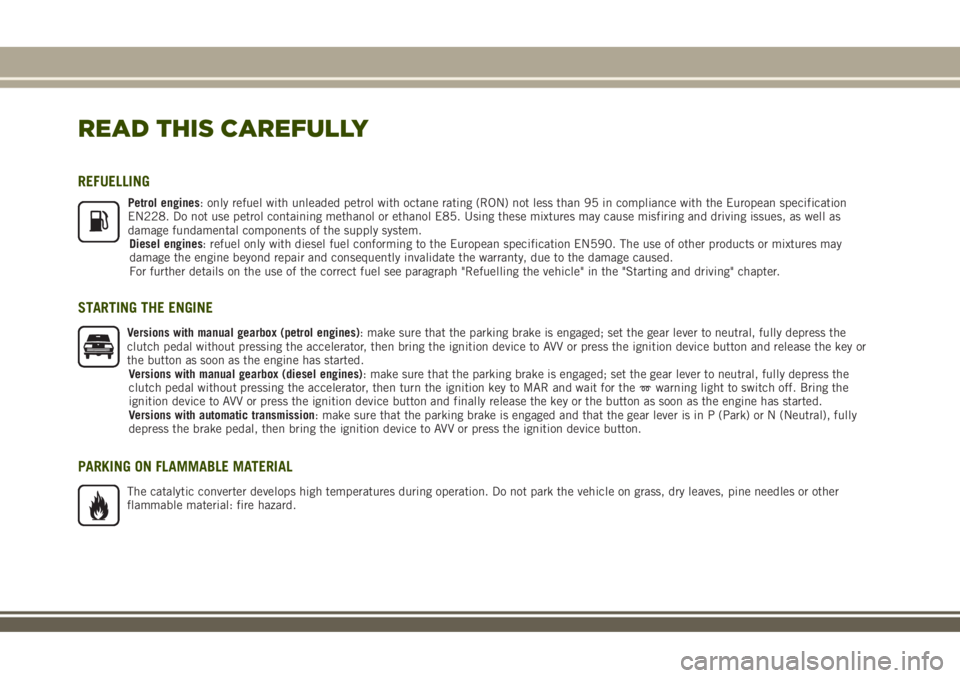
READ THIS CAREFULLY
REFUELLING
Petrol engines: only refuel with unleaded petrol with octane rating (RON) not less than 95 in compliance with the European specification
EN228. Do not use petrol containing methanol or ethanol E85. Using these mixtures may cause misfiring and driving issues, as well as
damage fundamental components of the supply system.
Diesel engines: refuel only with diesel fuel conforming to the European specification EN590. The use of other products or mixtures may
damage the engine beyond repair and consequently invalidate the warranty, due to the damage caused.
For further details on the use of the correct fuel see paragraph "Refuelling the vehicle" in the "Starting and driving" chapter.
STARTING THE ENGINE
Versions with manual gearbox (petrol engines): make sure that the parking brake is engaged; set the gear lever to neutral, fully depress the
clutch pedal without pressing the accelerator, then bring the ignition device to AVV or press the ignition device button and release the key or
the button as soon as the engine has started.
Versions with manual gearbox (diesel engines): make sure that the parking brake is engaged; set the gear lever to neutral, fully depress the
clutch pedal without pressing the accelerator, then turn the ignition key to MAR and wait for the
warning light to switch off. Bring the
ignition device to AVV or press the ignition device button and finally release the key or the button as soon as the engine has started.
Versions with automatic transmission: make sure that the parking brake is engaged and that the gear lever is in P (Park) or N (Neutral), fully
depress the brake pedal, then bring the ignition device to AVV or press the ignition device button.
PARKING ON FLAMMABLE MATERIAL
The catalytic converter develops high temperatures during operation. Do not park the vehicle on grass, dry leaves, pine needles or other
flammable material: fire hazard.
Page 20 of 356
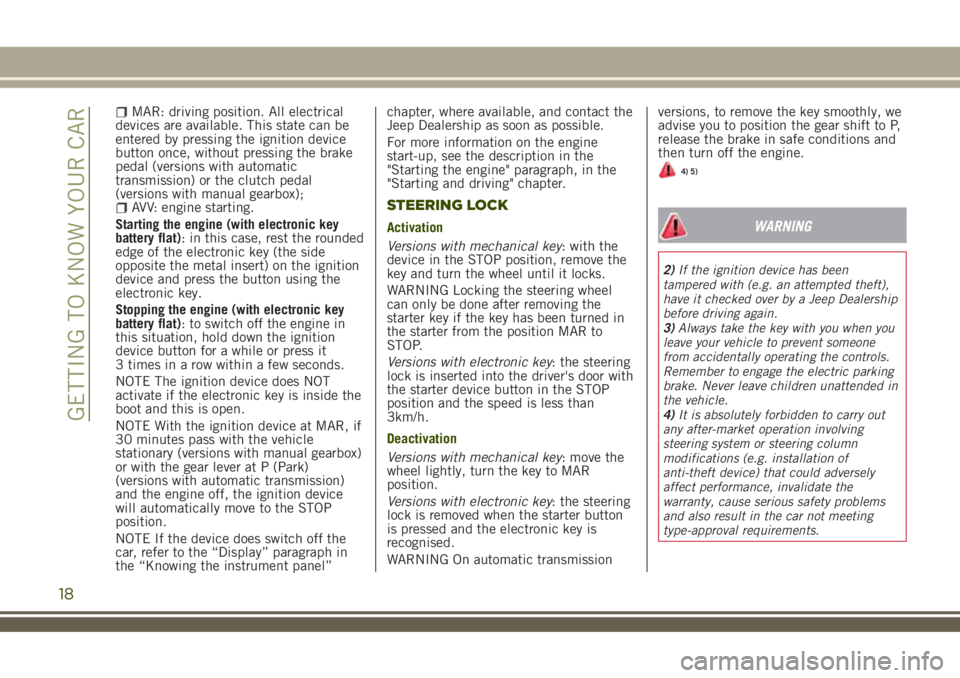
MAR: driving position. All electrical
devices are available. This state can be
entered by pressing the ignition device
button once, without pressing the brake
pedal (versions with automatic
transmission) or the clutch pedal
(versions with manual gearbox);
AVV: engine starting.
Starting the engine (with electronic key
battery flat): in this case, rest the rounded
edge of the electronic key (the side
opposite the metal insert) on the ignition
device and press the button using the
electronic key.
Stopping the engine (with electronic key
battery flat): to switch off the engine in
this situation, hold down the ignition
device button for a while or press it
3 times in a row within a few seconds.
NOTE The ignition device does NOT
activate if the electronic key is inside the
boot and this is open.
NOTE With the ignition device at MAR, if
30 minutes pass with the vehicle
stationary (versions with manual gearbox)
or with the gear lever at P (Park)
(versions with automatic transmission)
and the engine off, the ignition device
will automatically move to the STOP
position.
NOTE If the device does switch off the
car, refer to the “Display” paragraph in
the “Knowing the instrument panel”chapter, where available, and contact the
Jeep Dealership as soon as possible.
For more information on the engine
start-up, see the description in the
"Starting the engine" paragraph, in the
"Starting and driving" chapter.STEERING LOCK
Activation
Versions with mechanical key: with the
device in the STOP position, remove the
key and turn the wheel until it locks.
WARNING Locking the steering wheel
can only be done after removing the
starter key if the key has been turned in
the starter from the position MAR to
STOP.
Versions with electronic key: the steering
lock is inserted into the driver's door with
the starter device button in the STOP
position and the speed is less than
3km/h.
Deactivation
Versions with mechanical key: move the
wheel lightly, turn the key to MAR
position.
Versions with electronic key: the steering
lock is removed when the starter button
is pressed and the electronic key is
recognised.
WARNING On automatic transmissionversions, to remove the key smoothly, we
advise you to position the gear shift to P,
release the brake in safe conditions and
then turn off the engine.
4) 5)
WARNING
2)If the ignition device has been
tampered with (e.g. an attempted theft),
have it checked over by a Jeep Dealership
before driving again.
3)Always take the key with you when you
leave your vehicle to prevent someone
from accidentally operating the controls.
Remember to engage the electric parking
brake. Never leave children unattended in
the vehicle.
4)It is absolutely forbidden to carry out
any after-market operation involving
steering system or steering column
modifications (e.g. installation of
anti-theft device) that could adversely
affect performance, invalidate the
warranty, cause serious safety problems
and also result in the car not meeting
type-approval requirements.
18
GETTING TO KNOW YOUR CAR
Page 87 of 356
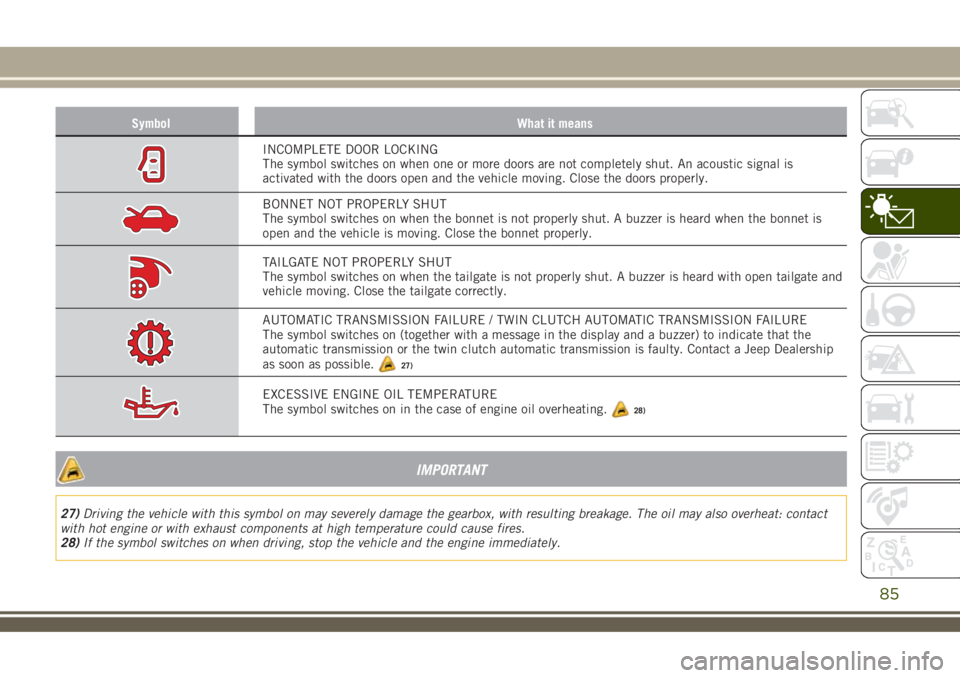
Symbol What it means
INCOMPLETE DOOR LOCKING
The symbol switches on when one or more doors are not completely shut. An acoustic signal is
activated with the doors open and the vehicle moving. Close the doors properly.
BONNET NOT PROPERLY SHUT
The symbol switches on when the bonnet is not properly shut. A buzzer is heard when the bonnet is
open and the vehicle is moving. Close the bonnet properly.
TAILGATE NOT PROPERLY SHUT
The symbol switches on when the tailgate is not properly shut. A buzzer is heard with open tailgate and
vehicle moving. Close the tailgate correctly.
AUTOMATIC TRANSMISSION FAILURE / TWIN CLUTCH AUTOMATIC TRANSMISSION FAILURE
The symbol switches on (together with a message in the display and a buzzer) to indicate that the
automatic transmission or the twin clutch automatic transmission is faulty. Contact a Jeep Dealership
as soon as possible.
27)
EXCESSIVE ENGINE OIL TEMPERATURE
The symbol switches on in the case of engine oil overheating.28)
IMPORTANT
27)Driving the vehicle with this symbol on may severely damage the gearbox, with resulting breakage. The oil may also overheat: contact
with hot engine or with exhaust components at high temperature could cause fires.
28)If the symbol switches on when driving, stop the vehicle and the engine immediately.
85
Page 92 of 356
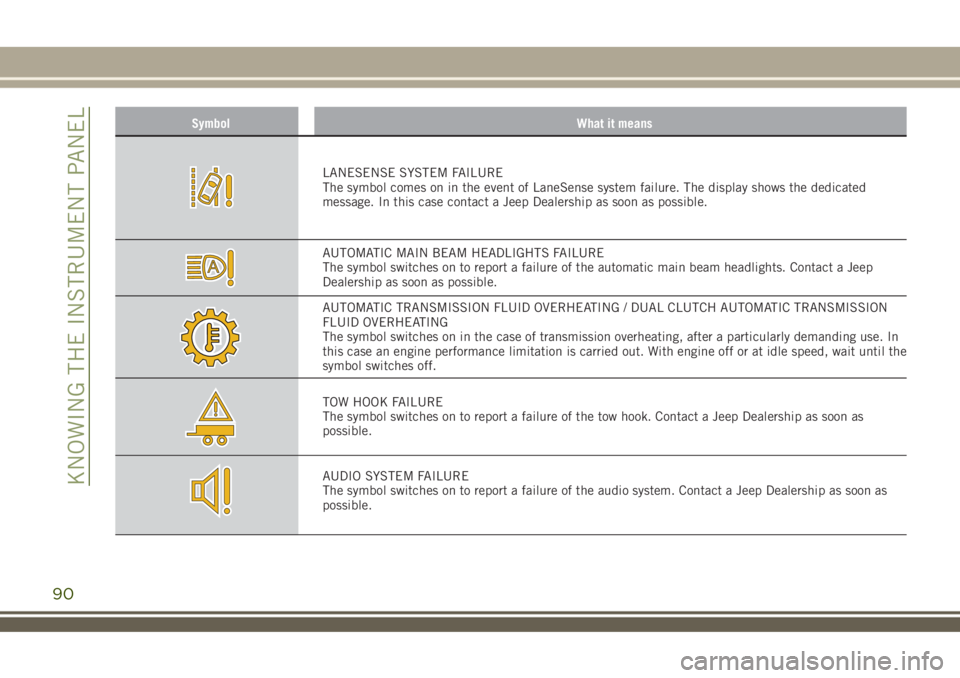
Symbol What it means
LANESENSE SYSTEM FAILURE
The symbol comes on in the event of LaneSense system failure. The display shows the dedicated
message. In this case contact a Jeep Dealership as soon as possible.
AUTOMATIC MAIN BEAM HEADLIGHTS FAILURE
The symbol switches on to report a failure of the automatic main beam headlights. Contact a Jeep
Dealership as soon as possible.
AUTOMATIC TRANSMISSION FLUID OVERHEATING / DUAL CLUTCH AUTOMATIC TRANSMISSION
FLUID OVERHEATING
The symbol switches on in the case of transmission overheating, after a particularly demanding use. In
this case an engine performance limitation is carried out. With engine off or at idle speed, wait until the
symbol switches off.
TOW HOOK FAILURE
The symbol switches on to report a failure of the tow hook. Contact a Jeep Dealership as soon as
possible.
AUDIO SYSTEM FAILURE
The symbol switches on to report a failure of the audio system. Contact a Jeep Dealership as soon as
possible.
90
KNOWING THE INSTRUMENT PANEL
Page 112 of 356
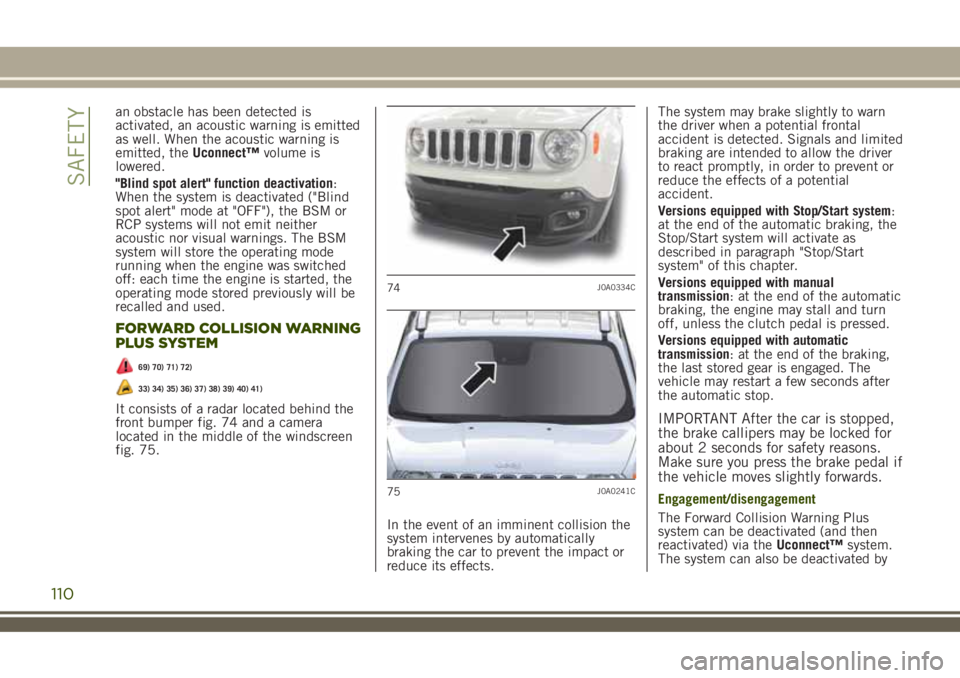
an obstacle has been detected is
activated, an acoustic warning is emitted
as well. When the acoustic warning is
emitted, theUconnect™volume is
lowered.
"Blind spot alert" function deactivation:
When the system is deactivated ("Blind
spot alert" mode at "OFF"), the BSM or
RCP systems will not emit neither
acoustic nor visual warnings. The BSM
system will store the operating mode
running when the engine was switched
off: each time the engine is started, the
operating mode stored previously will be
recalled and used.
FORWARD COLLISION WARNING
PLUS SYSTEM
69) 70) 71) 72)
33) 34) 35) 36) 37) 38) 39) 40) 41)
It consists of a radar located behind the
front bumper fig. 74 and a camera
located in the middle of the windscreen
fig. 75.
In the event of an imminent collision the
system intervenes by automatically
braking the car to prevent the impact or
reduce its effects.The system may brake slightly to warn
the driver when a potential frontal
accident is detected. Signals and limited
braking are intended to allow the driver
to react promptly, in order to prevent or
reduce the effects of a potential
accident.
Versions equipped with Stop/Start system:
at the end of the automatic braking, the
Stop/Start system will activate as
described in paragraph "Stop/Start
system" of this chapter.
Versions equipped with manual
transmission: at the end of the automatic
braking, the engine may stall and turn
off, unless the clutch pedal is pressed.
Versions equipped with automatic
transmission: at the end of the braking,
the last stored gear is engaged. The
vehicle may restart a few seconds after
the automatic stop.IMPORTANT After the car is stopped,
the brake callipers may be locked for
about 2 seconds for safety reasons.
Make sure you press the brake pedal if
the vehicle moves slightly forwards.
Engagement/disengagement
The Forward Collision Warning Plus
system can be deactivated (and then
reactivated) via theUconnect™system.
The system can also be deactivated by
74J0A0334C
75J0A0241C
110
SAFETY
Page 147 of 356
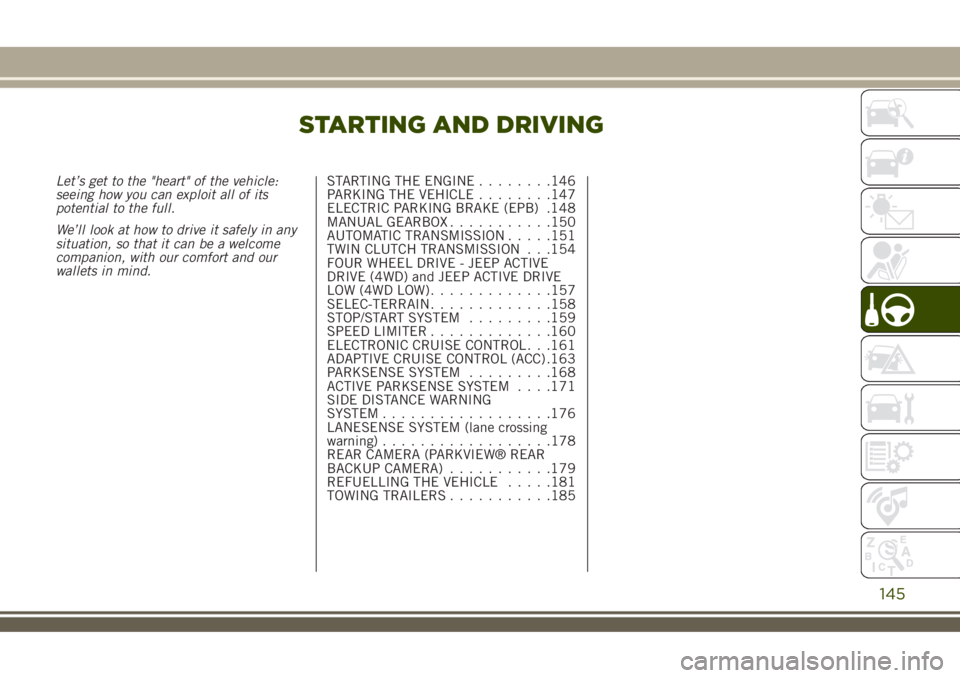
STARTING AND DRIVING
Let’s get to the "heart" of the vehicle:
seeing how you can exploit all of its
potential to the full.
We’ll look at how to drive it safely in any
situation, so that it can be a welcome
companion, with our comfort and our
wallets in mind.STARTING THE ENGINE........146
PARKING THE VEHICLE........147
ELECTRIC PARKING BRAKE (EPB) .148
MANUAL GEARBOX...........150
AUTOMATIC TRANSMISSION.....151
TWIN CLUTCH TRANSMISSION . . .154
FOUR WHEEL DRIVE - JEEP ACTIVE
DRIVE (4WD) and JEEP ACTIVE DRIVE
LOW (4WD LOW).............157
SELEC-TERRAIN.............158
STOP/START SYSTEM.........159
SPEED LIMITER.............160
ELECTRONIC CRUISE CONTROL . . .161
ADAPTIVE CRUISE CONTROL (ACC) .163
PARKSENSE SYSTEM.........168
ACTIVE PARKSENSE SYSTEM. . . .171
SIDE DISTANCE WARNING
SYSTEM..................176
LANESENSE SYSTEM (lane crossing
warning)..................178
REAR CAMERA (PARKVIEW® REAR
BACKUP CAMERA)...........179
REFUELLING THE VEHICLE.....181
TOWING TRAILERS...........185
145
Page 148 of 356
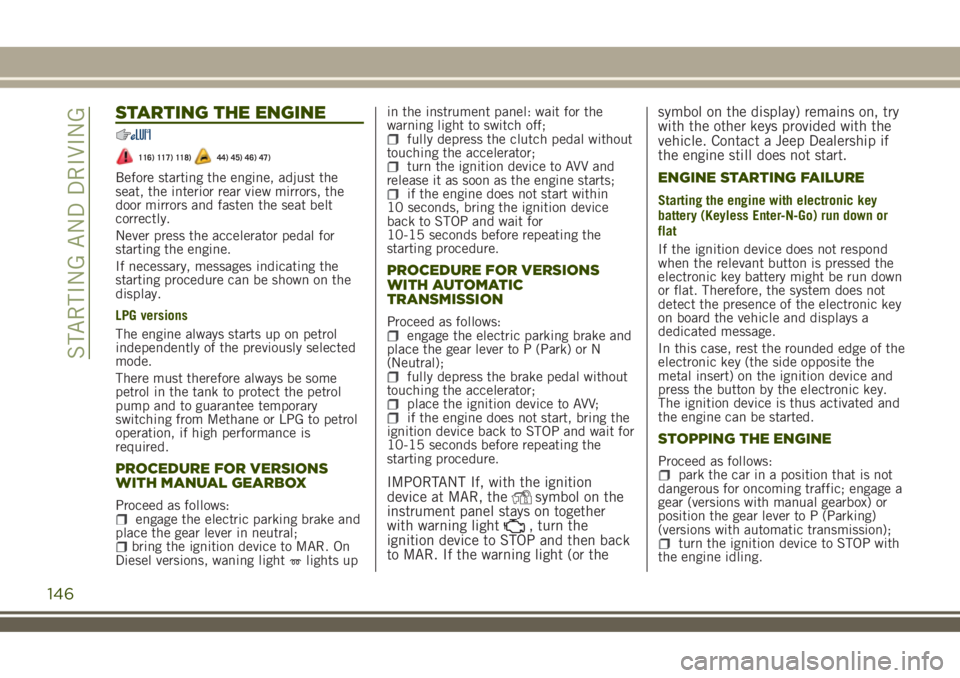
STARTING THE ENGINE
116) 117) 118)44) 45) 46) 47)
Before starting the engine, adjust the
seat, the interior rear view mirrors, the
door mirrors and fasten the seat belt
correctly.
Never press the accelerator pedal for
starting the engine.
If necessary, messages indicating the
starting procedure can be shown on the
display.
LPG versions
The engine always starts up on petrol
independently of the previously selected
mode.
There must therefore always be some
petrol in the tank to protect the petrol
pump and to guarantee temporary
switching from Methane or LPG to petrol
operation, if high performance is
required.
PROCEDURE FOR VERSIONS
WITH MANUAL GEARBOX
Proceed as follows:engage the electric parking brake and
place the gear lever in neutral;
bring the ignition device to MAR. On
Diesel versions, waning lightlights upin the instrument panel: wait for the
warning light to switch off;
fully depress the clutch pedal without
touching the accelerator;
turn the ignition device to AVV and
release it as soon as the engine starts;
if the engine does not start within
10 seconds, bring the ignition device
back to STOP and wait for
10-15 seconds before repeating the
starting procedure.
PROCEDURE FOR VERSIONS
WITH AUTOMATIC
TRANSMISSION
Proceed as follows:engage the electric parking brake and
place the gear lever to P (Park) or N
(Neutral);
fully depress the brake pedal without
touching the accelerator;
place the ignition device to AVV;if the engine does not start, bring the
ignition device back to STOP and wait for
10-15 seconds before repeating the
starting procedure.
IMPORTANT If, with the ignition
device at MAR, thesymbol on the
instrument panel stays on together
with warning light
, turn the
ignition device to STOP and then back
to MAR. If the warning light (or thesymbol on the display) remains on, try
with the other keys provided with the
vehicle. Contact a Jeep Dealership if
the engine still does not start.
ENGINE STARTING FAILURE
Starting the engine with electronic key
battery (Keyless Enter-N-Go) run down or
flat
If the ignition device does not respond
when the relevant button is pressed the
electronic key battery might be run down
or flat. Therefore, the system does not
detect the presence of the electronic key
on board the vehicle and displays a
dedicated message.
In this case, rest the rounded edge of the
electronic key (the side opposite the
metal insert) on the ignition device and
press the button by the electronic key.
The ignition device is thus activated and
the engine can be started.
STOPPING THE ENGINE
Proceed as follows:park the car in a position that is not
dangerous for oncoming traffic; engage a
gear (versions with manual gearbox) or
position the gear lever to P (Parking)
(versions with automatic transmission);
turn the ignition device to STOP with
the engine idling.
146
STARTING AND DRIVING
Page 149 of 356

Cars equipped with electronic key (Keyless
Enter-N-Go):at a car speed over 8 km/h
(5 mph) it is possible to switch the
engine off, also with automatic
transmission lever in a position other
than P (Parking). To switch off the engine
in this situation, hold down the ignition
device button for a while or press it
3 times in a row within a few seconds. In
this case the engine will stop and the
ignition device will switch to MAR.
WARNING
116)It is dangerous to run the engine in
enclosed areas. The engine takes in
oxygen and releases carbon dioxide,
carbon monoxide and other toxic gases.
117)The brake servo is not active until
the engine is started, so you would need
to apply much more force than usual to
the brake pedal.
118)Do not start the engine by pushing,
towing or driving downhill. These
manoeuvres may damage the catalytic
converter.
IMPORTANT
44)We recommend that during the initial
period, or during the first 1600 km
(1000 miles), you do not drive to full car
performance (e.g. excessive acceleration,
long journeys at top speed, sharp braking,
etc.).
45)When the engine is switched off never
leave the ignition device in the MAR
position to prevent useless current
absorption from draining the battery.
46)A quick burst on the accelerator before
turning off the engine serves absolutely no
practical purpose; it wastes fuel and is
damaging for the engine.
47)Warning light
will flash after
starting or during prolonged cranking to
indicate a fault with the glow plug heating
system. If the engine starts, the vehicle
can be regularly used, but a Jeep
Dealership must be contacted as soon as
possible.
PARKING THE VEHICLE
Always remove the ignition key when
leaving the car.
When parking and leaving the car,
proceed as follows:
engage a gear (1st gear if facing uphill
or reverse if facing downhill) and leave
the wheels turned;
stop the engine and engage the
handbrake.
Block the wheels with a wedge or a stone
if the car is parked on a steep slope.
On versions equipped with automatic
transmission or dual clutch automatic
transmission, wait for the letter P to be
displayed before releasing the brake
pedal.
IMPORTANT NEVER leave the car with
the gearbox in neutral (or, on versions
equipped with automatic transmission
or dual clutch automatic transmission,
before putting the shift lever in the P
position).
147
Page 151 of 356
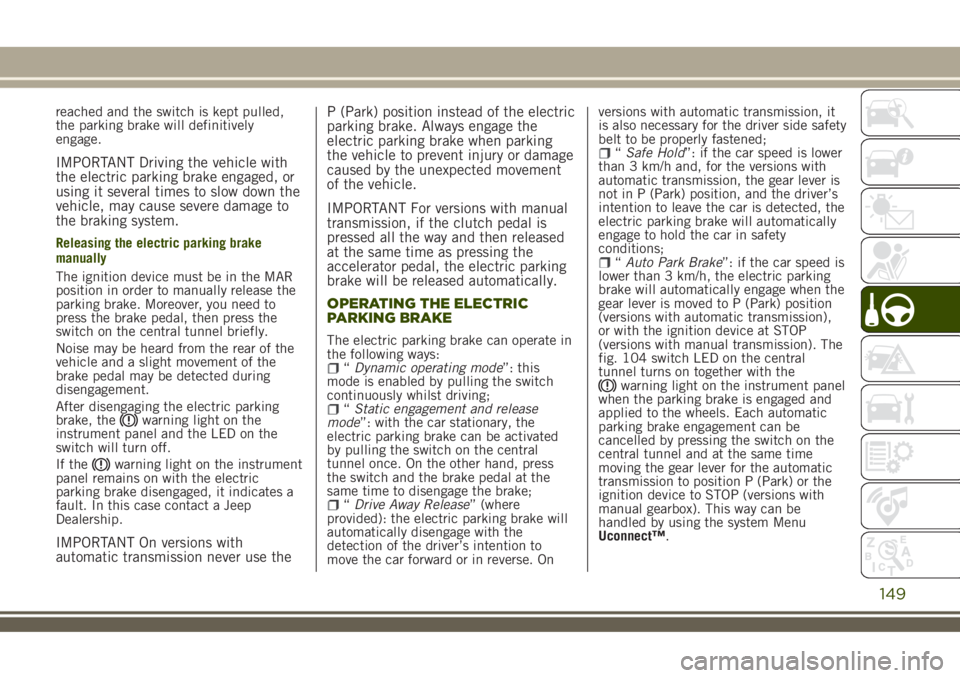
reached and the switch is kept pulled,
the parking brake will definitively
engage.
IMPORTANT Driving the vehicle with
the electric parking brake engaged, or
using it several times to slow down the
vehicle, may cause severe damage to
the braking system.
Releasing the electric parking brake
manually
The ignition device must be in the MAR
position in order to manually release the
parking brake. Moreover, you need to
press the brake pedal, then press the
switch on the central tunnel briefly.
Noise may be heard from the rear of the
vehicle and a slight movement of the
brake pedal may be detected during
disengagement.
After disengaging the electric parking
brake, the
warning light on the
instrument panel and the LED on the
switch will turn off.
If the
warning light on the instrument
panel remains on with the electric
parking brake disengaged, it indicates a
fault. In this case contact a Jeep
Dealership.
IMPORTANT On versions with
automatic transmission never use theP (Park) position instead of the electric
parking brake. Always engage the
electric parking brake when parking
the vehicle to prevent injury or damage
caused by the unexpected movement
of the vehicle.
IMPORTANT For versions with manual
transmission, if the clutch pedal is
pressed all the way and then released
at the same time as pressing the
accelerator pedal, the electric parking
brake will be released automatically.
OPERATING THE ELECTRIC
PARKING BRAKE
The electric parking brake can operate in
the following ways:
“Dynamic operating mode”: this
mode is enabled by pulling the switch
continuously whilst driving;
“Static engagement and release
mode”: with the car stationary, the
electric parking brake can be activated
by pulling the switch on the central
tunnel once. On the other hand, press
the switch and the brake pedal at the
same time to disengage the brake;
“Drive Away Release” (where
provided): the electric parking brake will
automatically disengage with the
detection of the driver’s intention to
move the car forward or in reverse. Onversions with automatic transmission, it
is also necessary for the driver side safety
belt to be properly fastened;
“Safe Hold”: if the car speed is lower
than 3 km/h and, for the versions with
automatic transmission, the gear lever is
not in P (Park) position, and the driver’s
intention to leave the car is detected, the
electric parking brake will automatically
engage to hold the car in safety
conditions;
“Auto Park Brake”: if the car speed is
lower than 3 km/h, the electric parking
brake will automatically engage when the
gear lever is moved to P (Park) position
(versions with automatic transmission),
or with the ignition device at STOP
(versions with manual transmission). The
fig. 104 switch LED on the central
tunnel turns on together with the
warning light on the instrument panel
when the parking brake is engaged and
applied to the wheels. Each automatic
parking brake engagement can be
cancelled by pressing the switch on the
central tunnel and at the same time
moving the gear lever for the automatic
transmission to position P (Park) or the
ignition device to STOP (versions with
manual gearbox). This way can be
handled by using the system Menu
Uconnect™.
149
Page 152 of 356
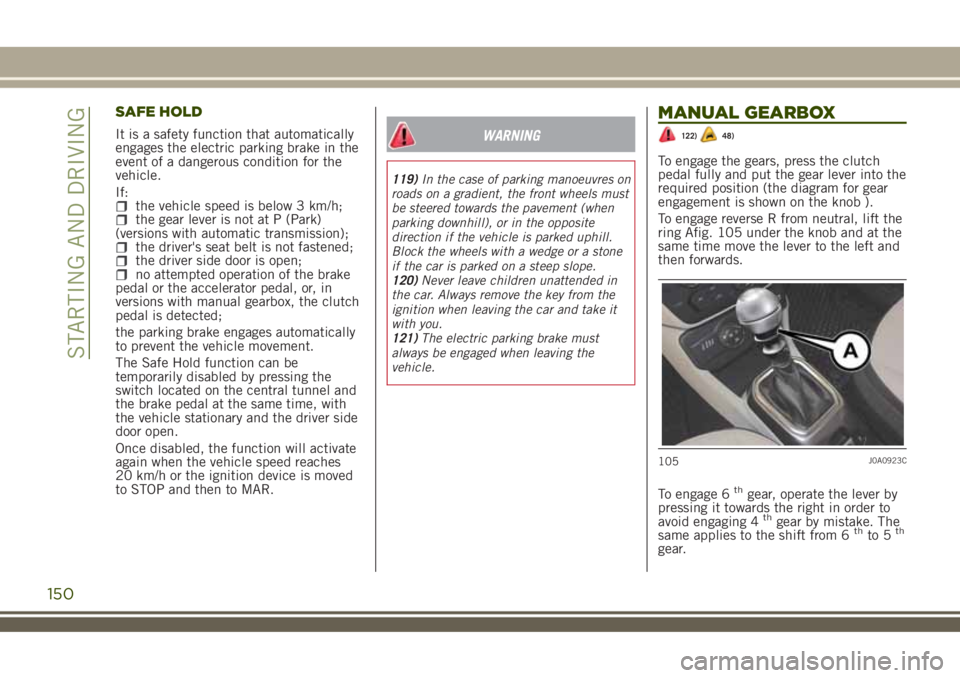
SAFE HOLD
It is a safety function that automatically
engages the electric parking brake in the
event of a dangerous condition for the
vehicle.
If:
the vehicle speed is below 3 km/h;the gear lever is not at P (Park)
(versions with automatic transmission);
the driver's seat belt is not fastened;the driver side door is open;no attempted operation of the brake
pedal or the accelerator pedal, or, in
versions with manual gearbox, the clutch
pedal is detected;
the parking brake engages automatically
to prevent the vehicle movement.
The Safe Hold function can be
temporarily disabled by pressing the
switch located on the central tunnel and
the brake pedal at the same time, with
the vehicle stationary and the driver side
door open.
Once disabled, the function will activate
again when the vehicle speed reaches
20 km/h or the ignition device is moved
to STOP and then to MAR.
WARNING
119)In the case of parking manoeuvres on
roads on a gradient, the front wheels must
be steered towards the pavement (when
parking downhill), or in the opposite
direction if the vehicle is parked uphill.
Block the wheels with a wedge or a stone
if the car is parked on a steep slope.
120)Never leave children unattended in
the car. Always remove the key from the
ignition when leaving the car and take it
with you.
121)The electric parking brake must
always be engaged when leaving the
vehicle.
MANUAL GEARBOX
122)48)
To engage the gears, press the clutch
pedal fully and put the gear lever into the
required position (the diagram for gear
engagement is shown on the knob ).
To engage reverse R from neutral, lift the
ring Afig. 105 under the knob and at the
same time move the lever to the left and
then forwards.
To engage 6
thgear, operate the lever by
pressing it towards the right in order to
avoid engaging 4
thgear by mistake. The
same applies to the shift from 6thto 5th
gear.
105J0A0923C
150
STARTING AND DRIVING